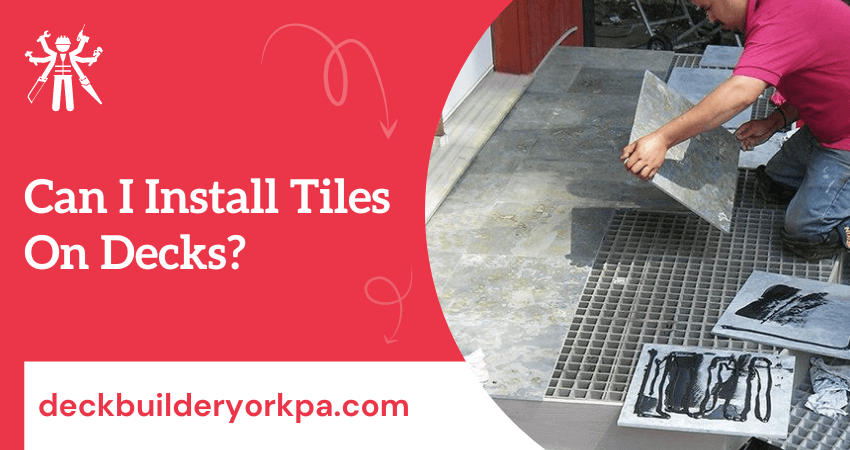If you’re looking to upgrade your outdoor living space and give it a whole new look, installing tiles on your deck might just be the perfect solution. It can help increase the aesthetic appeal of the area while also protecting it from the elements.
But before you get started with this exciting project, there’s one major question you must answer: Can I install tiles on composite or wood decks?
In this post, we’re going to explore this topic in detail by discussing what options are available for each type of material along with any installation tips that will make all the difference.
By understanding exactly how to go about installing tiles for different deck types, you’ll have no trouble giving your outdoor entertainment areas a fresh new look!
Can I Install Tiles on Composite or Wood Decks?
Yes, you can install tiles on composite or wood decks. However, there are a few things to keep in mind when doing so. First, make sure that the deck surface is completely clean and free of dirt and debris before starting the installation process. You’ll also want to check for any loose boards that need to be secured.
Additionally, you’ll want to make sure that the deck is structurally sound and level. Once these steps are complete, you can begin laying down your tiles. Depending on the type of tiles being used, you may need to use a waterproofing membrane or adhesive to ensure they stay secure. When installing tiles on composite or wood decks, it’s important to follow the manufacturer’s directions closely. This will help ensure a safe and successful installation that provides years of enjoyment.
Once you have prepared the deck surface and purchased your tiles, you can move on to installing them. You’ll want to start by marking out where the tile should go with a pencil or chalk line. Then, using a drill and appropriate screws, secure the tiles. Be sure to use a spacing jig or other measuring tool to make sure that each tile is spaced evenly apart.
In addition, you’ll need to pay attention to any grouting instructions and follow them carefully to ensure your deck looks its best when finished.
How to install tiles on composite or wood decks?
First, you’ll want to determine the surface area of your deck and use a measuring tape to measure the dimensions. Then, you should decide what type of tile material would be best suited for your deck. Ceramic or porcelain tiles are one option, while natural stone such as slate is another excellent choice.
- Once you have chosen the right tiles, you’ll need to prepare the surface of your deck. This includes cleaning the area and ensuring that it is level. If necessary, you should use a trowel or grinder to create an even surface that is suitable for tile installation.
- Next, you need to choose between two common methods: Thin-set and mortar installation. With a thin set, you will need to spread a thin layer of mortar on the deck and press the tiles into it. Mortar installation requires more skill, as you must delicately spread the mortar between each tile before pressing them into place. Once all the tiles are in place, use spacers to ensure that they have even spacing before allowing them to dry.
- Finally, you will need to use grout to fill the gaps between each tile and complete the installation. Your deck is now ready for use!
By following the steps outlined above, you can confidently install tile on your deck. Have fun and enjoy your newly renovated outdoor space!
Once you have completed your tile installation, remember to take the necessary steps to maintain it. This includes re-sealing the tiles every few years and regularly cleaning them with mild detergent. With proper care and maintenance, your deck will stay in good condition for years to come.
Are there any risks associated with installing tiles on composite or wood decks?
Yes, there are some risks associated with installing tiles on composite or wood decks:
- Moisture can cause the underlying deck material to rot or warp over time.
- Unsealed tiles can crack over time due to expanding and contracting temperatures.
- Grout lines between tiles may fill with water, leading to the growth of mold, mildew and other contaminants.
- Tiles can be slippery when wet, leading to potential slips and falls.
- Improperly installed tiles can cause permanent damage to the underlying deck material.
- Over time, exposed nails or screws used to secure the tiles may rust and damage the deck.
- Tiles can be easily broken and cracked by foot traffic or objects being dropped on them.
- Regular maintenance is required to keep tiles looking their best including cleaning and resealing grout lines.
- If not installed properly, tiles may come loose over time due to the movement of the underlying deck material.
- Tiles can be expensive to replace if damaged or broken.
You must consult with a deck construction professional if you are considering installing tiles on your composite or wood deck, to ensure that the job is done properly and safely. By taking the necessary precautions, you can ensure a successful tile installation and avoid any major problems in the future.
Some tips for maintaining your deck once the tiles have been installed?
- Clean your deck regularly: Use mild detergent and water to clean your deck. This will help keep dirt and other debris from building up on the surface, preventing it from becoming slippery or unsightly.
- Check for damage: Regularly inspect the tiles and surrounding structure of your deck to ensure there is no damage. If any tiles are cracked or loose, replace them immediately to prevent further damage.
- Seal your Deck: Applying a sealant or coating to the deck surface will help protect it from water and UV damage. Be sure to follow the manufacturer’s instructions when applying sealants as some may require multiple coats for maximum protection.
- Have someone inspect your Deck: Have a professional inspect your deck at least once a year to ensure that it is still in good condition. They can perform necessary repairs or replacements as needed. This will help extend the life of your deck and prevent major problems in the future.
- Regularly maintain and repair any damage: If any damage is noticed, repair it immediately. This will prevent further wear and tear on the deck and help ensure its longevity. Keeping up with regular maintenance will also help you catch problems before they become serious.
- Use furniture pads to protect the tiles: Placing furniture pads under outdoor furniture can help protect your tiles from scratches and damage. These can be easily removed and replaced when necessary.
- Keep the deck clear of debris: Regularly sweep away any leaves or other debris that may accumulate on your deck. This will help prevent damage to the tiles and keep it looking neat.
- Store outdoor furniture indoors during extreme weather: If you have outdoor furniture that is made from wood or metal, it’s best to store it indoors during extreme temperature changes. This will help protect the furniture and your deck tiles from any potential damage.
Following these tips will help ensure the long life of your deck and keep it looking great for years to come!
Wrap Up
Ultimately, you can install outdoor tiles on composite or wood decks, although it is easier to install tile on a concrete surface. Installing tiles on wood or composite decks isn’t all that difficult. You’ll just need to take the time to plan out your project and make sure you have the right materials and tools.
The biggest obstacle you’ll face is making sure you thoroughly prep your deck, as tile needs a proper surface and an unyielding water barrier beneath the material. If you’re unsure of how to go about this yourself, consider hiring a professional contractor who knows how to properly lay and maintain your tiles and decking so you’ll be left with a safe and aesthetically pleasing space.



